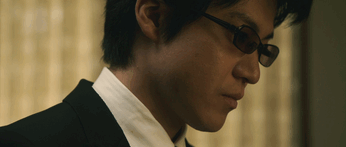 Cat-Loving Haruki Murakami and the Abundance of Movie Adaptations
Cat-Loving Haruki Murakami and the Abundance of Movie Adaptations

If you take a look at Wikipedia's list of the highest-grossing films in Japan, you will find the three top spots occupied by an anime (Spirited Away), Hollywood blockbuster (Titanic), and a Disney animation (Frozen), respectively. If you look closer, however, you will notice a specific Japanese movie which set the box office record in 2003 (over 17 billion yen) and remains unbeaten to date as a live-action domestic production. This movie is Bayside Shakedown: The Movie 2, part of the franchise known initially as Odoru Daisousasen.
The idea for this article stemmed from a godforsaken forum thread (at the time of writing this text I was unable to retrieve the link) where “a cinema connoisseur” claimed that nothing good ever came out in Japanese cinema throughout the 2000s and Bayside Shakedown series is the best example of that because it is structured precisely just like a standard asadora for bored housewives…
|
I know that this sounds like some troll attack, but the argument got me thinking: “Did Bayside Shakedown really destroy Japanese Cinema?”
Well, first things first and some introductory information is very much needed to those unfamiliar with the series. Odoru Daisousasen (Western title: Bayside Shakedown) started in 1997 as an 11-episode drama. It tells the story of a young up-and-coming police officer Shunsaku Aoshima (Yuji Oda) who finally becomes a detective and is assigned to the fictional Wangan Police Station of the Tokyo Metropolitan Police Department. Aoshima quickly realises that his new job is not about spectacular shootouts, car chases, and explosions. Instead, police work is more like “office politics with bureaucratic red tape, lethargic civil servants, bosses more interested in playing golf and saving face than solving the crime” (source). Nevertheless, a new detective soon finds motivation and excitement as he makes friends with fellow WPS officers and cracks a series of big (and small) cases throughout the series.

The drama became such a massive success on FujiTV that it ultimately spawned four TV specials, four theatrical movies, two spin-off films, and a stage-play. Can you recall the trend when there is a successful drama followed by an SP and a movie? Bayside Shakedown started it all! Although director Katsuyuki Motohiro mentioned that only the drama and the first movie were initially planned (source), the TV ratings as well as VHS/DVD sales were so high that FujiTV commissioned more follow-ups and, as a result, the series grew to become a vast, financially successful franchise over the course of 15 years.
Nevertheless, is Bayside Shakedown really asadora-like? Well, I would say that it is not just a typical soap opera tearjerker but rather a well-made mixture of police drama and comedy. It may be hard to imagine but think of it in terms of NYPD Blue meets Police Academy: there are severe bits as well as lots of moments where hilarity ensues. So, what makes Bayside Shakedown work?
The Characters |

The chemistry and dynamics between the main characters is the main driving force of this series. Yuji Oda as Detective Shunsaku Aoshima is brilliant, but his sole presence as the lead is not enough. Aoshima is accompanied by Onda Sumire (Eri Fukatsu): an independent woman with a strong affinity for consuming food, Kashiwagi Yukino (Miki Mizuno): a traumatised witness of her father’s death, Senior Inspector Waku (Chosuke Ikariya): the eldest detective in the section and a mentor figure to Aoshima, Assistant Inspector Masayoshi Mashita (Yusuke Santamaria): a bit cowardly but extremely likable member of the “career group”, Division Chief Jiro Uozumi (Kenta Satoi): a well-mannered detective who secretly dreads Mashita’s development up the career ladder.
The Bromance |

Apart from the aforementioned characters, there is yet another one, Superintendent Shinji Muroi (Toshiro Yanagiba), the top man from HQ’s investigative division. When he steps into action, literally sh*t gets real. He often crosses paths with Aoshima, and the young detective gradually changes Muroi’s perspective on how the police should work. Initially being a cold and emotionless bureaucrat, he eventually befriends Aoshima and shows his compassionate side. The bromance level between the two is off the charts, and it is definitely my favourite aspect of the whole franchise.
The Music Score |

Honestly, Bayside Shakedown would have been nothing without the crazy awesome music by Akihito Matsumoto. The earbreaking “Rhythm and Police” theme will get you pumped for some police action. Apart from that, get ready for some epic guitar riffs, choral arrangements, and Maxi Priest’s multiple versions of “Love Somebody”.
The Message |

Each entry in the series always ends on the same note. No matter how hard it is, how many obstacles are there, always try to achieve your goal. Fight bureaucracy, fight villains and rage your dream. There is still a chance to make things better.
Coming back to the original argument. Bayside Shakedown is undoubtedly not an asadora-type of show, and it most certainly did not destroy Japanese cinema. The only thing it destroyed was the Japanese box office. This franchise is hugely entertaining, gripping, and best of the best. In fact, one can see the seeds of Bayside Shakedown in modern cop dramas like Tokyo Dogs, Bitter Blood, doS Deka or The Last Cop. The legacy of the franchise is so tangible that you can hear the theme song on the subway or visit the real Tokyo Wangan Police Station that was named after the fictional one from the drama. I only regret that the series ended back in 2012 with the release of Bayside Shakedown 4: The Final as the last movie.
Sources: Asianwiki * Midnight Eye interview: Katsuyuki Motohiro * Tokyo Teleport Station * Tokyo Wangan Police Station * Highest Grossing Films in Japan * Geeknights Podcast












